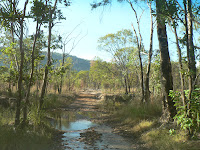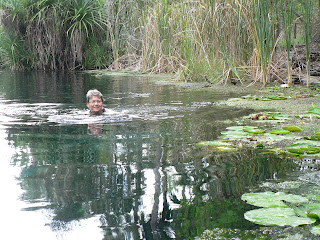 |
| A boab tree |
It was a very hot day, the hottest so far that we experienced. 34 degrees all afternoon, and even now, more than an hour after sunset it is above 30 degrees in the van. The fan in the ceiling does not help much. Hope it will cool down a bit more over the evening so that we can sleep.
Sunday, 17 June, Kununurra - It took a long time yesterday evening to cool down, and even the night was warm, at sunrise it was still 24 degrees. Just an hour after breakfast we got to the WA border, with two short stops to finish off with our remaining fruit supply that can't be taken to WA. The quarantine inspection went smoothly and quickly, no problems. By around 11 am we gont into Kununurra.
In fact, it was 11 am Northern Territory time, but in WA it was only 9.30 am, a big change, showing how far we came from Sydney, 2 hours time difference. But both NT and WA times are a bit misaligned with the "real" time of day. In NT sunrise was only around 7.15 am, and sunset at 6.15 pm, now in Kununurra we just saw the sun going down exactly at 5pm. Anyway, we will get used to it.
 |
| Our campsite in Kununurra |
 |
| View of Kununurra from Kelly's Knob |
Monday, 18 June, Kununurra - It was strage to wake up to daylight around 6 am, 1.5 hours earlier than in NT, but we can easily get used to this. In the morning we went to Lake Argyle, about 70 kms from here. It is a nice easy and scenic drive among various red rock outcrops characteristic of the Kimberley region.
First we visited the Durack Homestead, moved up from its original place which is now under water and rebuilt as a museum showcasing the early life and the history of the Durack family.
Then we went on to several lookout points to get a view of the Ord River Dam and Lake Argyle, a vast man-made lake 21 times the size of Sydney Harbour. It is a beautiful sight the dark-blue water in between the red rock ranges with a bit of lush vegetation around the lake.
 |
| The Ord River Gorge below the dam |
 |
| A curious bird at the Lake Argyle picnic area |
We spent the afternoon in the camp, resting and chatting with a couple of fellow Eco Tourer owners, Brian and Maree, discussing our travel experiences and little tricks about our van.
Tuesday, 19 June, Kununurra - Today we did an excursion to Wyndham, the Northernmost town in WA, about 100 km from Kununurra. On the way up we made a detour on 23 km dirt road to see the "Prison Tree", a very old, enormous boab tree, with a huge cavity in its trunk, that was used in the early days to keep prisoners locked up inside overnight. The tree is said to be more than 2 thousand years old. It is a very interesting sight indeed.
 |
| The rivers at Wyndham Port |
 |
| Another giant boab tree in Wyndham |
On return to Kununurra we did some shopping then a quiet afternoon at the camp.
Wednesday, 20 June, Kununurra - This morning we had to move to a different place in the caravan park because a group was coming to the place originally given to us. It was only a short distance, but still we had to pack up the van completely and then set it up again, it took about an hour. Our new place is just beside the pool, also quite nice, apart from the continuous buzzing of the pool machinery day and night but we have to live with that, and we can.
 |
| At the Hoochery Distillery |
 |
| The Ivanhoe Crossing |
We came back to the camp by lunchtime and spent a lazy afternoon reading and resting.
 |
| King George Falls |
Thursday, 21 June, Kununurra - Today we went on a scenic flight around the Northern coast of the Kimberley. It was a very small aircraft, a Cessna-210, with a young female pilot. The flight took 4.5 hours, but it took almost all day with a stopover in Kalumburu, the Northernmost community in WA. It is hard to describe in words the magnificent scenery we saw all the way. There were several highlights: the North coastline with its pristine beaches and clear green-blue waters of the Timor sea, the King George Falls, and in the afternoon the Mitchell Falls and the Cockburn Ranges.
 |
| The altar in the Mission Temple |
After the museum we also saw the site where two WW2 aircrafts crashed, the scattered parts of the fuselage are still very impressive.
Apart from the highlight tourist attractions, flying low above the earth in a small plane is in itself a very interesting experience, almost any part of the landscape seems so beautiful from above. We thoroughly enjoyed this experience. We have several anniversaries coming up in the next few days, this was a collective present for both of us.
 |
| The Mitchell Falls |
 |
| The Cockburn Ranges and the Gibb River Road |
Tomorrow we head off to the Bungles!
Our itinerary can be seen at the following Google Map:
http://g.co/maps/wcwv8
(Note that to see the route after Bowen, you need to move down to the bottom of the right panel, and select the following pages!)
Szombaton reggel elindultunk Katherne-bol, és egy éjszakai szabad-kempingezés után vasárnap reggel átléptünk Nyugat-Ausztráliába és délelott 11 felé meg is érkeztünk Kununurra-ba. Pontosabban a határ-átlépéssel az órát is vissza kellett állítani másfél órával, úgyhogy itteni ido szerint fél tízkor érkeztünk. Hozzá kell szokni ehhez az ido-különbséghez. Eddig a Northern Territory-ban hét után kelt csak a nap, és este negyed 7 körül volt naplemente. Itt meg már reggel 6-kor kel a nap, viszont este 5-kor megy le, így jó hosszú téli estéink vannak. Igaz, hogy közel vagyunk a legrövidebb naphoz, ez nem is olyan meglepo.
Kununurra egy elég kis város, de a fo turista-idényben, ami most kezdodik, nagyon felduzzad, rengeteg a magunkfajta "gray nomad", no meg pár fiatalabb utazó, mi is elég nehezen kaptunk helyet a lakókocsinknak. Ez az észak-keleti kezdopontja a Kimberley-régiónak, az itteni leghíresebb turista-nevezetességnek.
Vasárnap óta itt töltöttük az idot, kisebb kirándulásokat tettünk a környéken, és sokat pihentünk ebben a kellemes kempingben. Egyik nap elmentünk a Lake Argyle-hoz, egy hatalmas mesterséges tó az Ord folyó gátja fölött. Több szép kilátó pontról lehet körülnézni a tóra és a környezo tipikus vöröses-barna szikladombokra. Mellette meglátogattunk egy régi farmházat is a 18. szd végérol, az egyik elso híres farmer család, a Durack család eredeti farmházát, amit szétszedtek és ujra felépítettek itt amikor a duzzasztás elkezdodött.
Egy másik nap kirándultunk Wyndham-ba, 100 km északra egy kis kikötovárosba, ami nem volt nagyon érdekes. Alig van benne élet mióta megszunt a mellette korábban muködo hús-feldolgozó üzem. Viszont a környezete elég érdekes, öt folyó jön itt össze egy kis helyen és közös torkolattal folyik a Cambridge öbölbe. Van egy kilátó-pont a városka fölött ahonnan mind az öt folyót be lehet látni. Egy másik érdekességért 23 km-es kitérot tettünk földuton: az ún. "börtön-fa", egy óriási boab-fa, aminek üreges a belseje és van egy nagy luk az oldalában, a régi idokben a rendorök útközben ide dugták be a foglyot éjszakára. A fa enélkül is csak a méreteivel fantasztikus látvány, több mint kétezer évesre becsülik. Láttunk egy másik hasonló méretu óriást is Wyndham-ban, luk és más történet nélkül, de az is gyönyöru volt.
Itt a környéken megnéztük a duzzasztóvból öntözött területeket, ahol most leginkább indiai sandal-fákat nevelnek, megnéztük a gyár bemutató-termét ahol remgeteg kölönféle kozmetikumot készítenek a fából sajtolt olajból. Aztán megnéztünk egy lepárló üzemet, ahol cukornádat dolgoznak fel, rumot és többféle likort csinálnak belole. Kóstolót is kaptunk, és végül vettünk is egy kis tartalékot a további útra.
Ma pedig egész különleges élményben volt részünk: elmentünk egy repülos kirándulásra. Majdnem egésznapos túra volt egy kis ötszemélyes gépen (Cessna-210) egy szimpatikus fiatal no pilótával, rengeteget láttunk, 4 és fél órát repültünk, fel a kontinens északi partja mentén nyugatra és kicsit délebbre vissza egy nagy körben, közben egy sor nevezet természeti szépséget láthattunk, folyóvölgyeket, vízeséseket, sziklás hegyláncokat, elhagyott tengerparti öblöket a Timor tenger partján. Délben leszálltunk egy Kalumburu nevu kis aboriginal faluban, ebédet is kaptunk és megnéztük a "misszió"-t amit Benedek-rendi barátok alapítottak 1913-ban. Láttuk a múzeumot rengeteg érdekes rajzzal-képpel faragással, és a misszió történetével. A nevezetsségek mellett maga a kis repüloben alacsonyan repülés is nagyon érdekes ujdonság volt nekem, a föld jelentéktelenebb részei is olyan szépek fölülrol. Persze jó sokba került, de nagyon élveztük, megérte. Ez volt a közös ajándék mindkettonk közeli ünnepeire.
Holnap reggel aztán tovább indulunk a következo látványosság felé.
Az útvonalunk a következo Google Map-on látható:
http://g.co/maps/wcwv8
(A Bowen utáni szakaszokhoz le kell menni a jobboldali panel aljára, és a következo oldalakra kattintani!!)











































